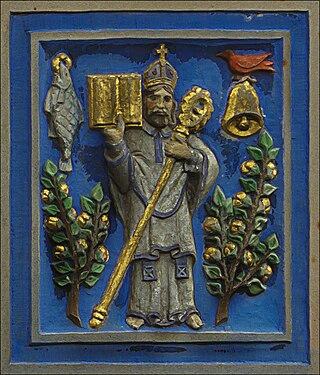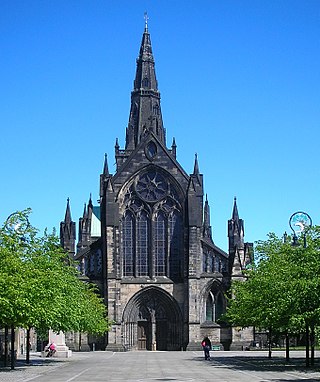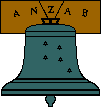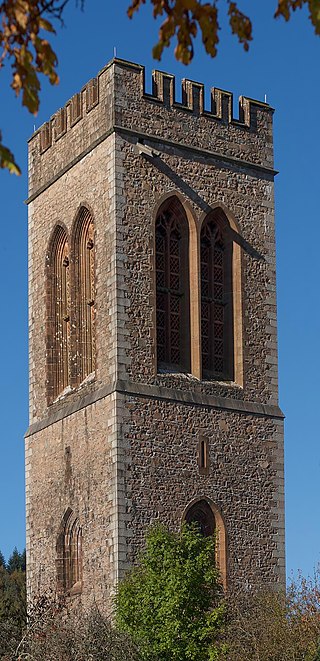
A dead bell or deid bell (Scots), also a 'death', 'mort', 'lych', 'passing bell' or 'skellet bell' [1] was a form of hand bell used in Scotland and northern England [2] in conjunction with deaths and funerals up until the 19th century.

A dead bell or deid bell (Scots), also a 'death', 'mort', 'lych', 'passing bell' or 'skellet bell' [1] was a form of hand bell used in Scotland and northern England [2] in conjunction with deaths and funerals up until the 19th century.
Belief in the supernatural was common in the Middle Ages and special protective powers were sometimes attributed to certain objects, including bells. The Church itself condoned the use of bells to frighten away evil spirits and this ensured the practice's survival and development. Bells were often baptised, and once baptised were believed by many to possess the power to ward off evil spells and spirits. [3] The use of the dead bell was typical of this belief, rung for the recently deceased to keep evil spirits away from the body. [4]
The dead bell was therefore originally rung for two reasons: firstly to seek the prayers of Christians for a dead person's soul, and secondly to drive away the evil spirits who stood at the foot of the dead person's bed and around the house. [5]
The use of the dead bell is illustrated on the Bayeux Tapestry at the funeral of Edward the Confessor and may have been brought over to Britain by the Normans. [6]

Before the Reformation, friars in Glasgow rang the dead bell through the streets for the repose of the soul of the deceased, especially if the individual was a benefactor of the church. It is known that the ancient bell of Saint Mungo (aka Saint Kentigern) was used for this purpose. From 1454 a record survives of the bell being rung annually [7] for the soul of Johne Steuart (John Stewart), the first Provost of Glasgow, who had left lands and property to the church. [8] A record of 1509 for Sir Archibald Crawford of Cadder also shows that the ringing of the dead bell sometimes took place more than once and was intended to encourage others to pray for the deceased, his ancestors, and other Christian souls. [9] In 1594 the presbytery of Glasgow attempted to recover the right of use of the dead bell, arguing that it was an ecclesiastical and not a secular function. [10]
The Ballad of Willie's Lyke-Wake from the north of Scotland records the payment of a groat for the ringing of the dead bell at his funeral by the bedral or bell-man. [11]
In later, secular times, the bell ringer would pass through the streets of villages, towns or cities announcing the name of a recently deceased person, with details of the funeral. At the funeral the bell ringer, often the beadle, would walk at the head the cortege, solemnly ringing the bell from the home of the deceased until the church was reached. [1] [12] The bell was also sometimes used to indicate the point at which the coffin-bearers were changed. [13]
The dead bell ringer was instructed to go through the town no more than twice and was not permitted to use the words "faithful" or "God". He was not permitted to ring the bell before sunrise or after sunset. [14]
Kirk session records show that in one Ayrshire parish the dead bell ringer was paid at a rate of a penny a mile at first, rising to two pence per mile by 1762. [13] The income from the ringing of the dead bell went to the kirk session and was used to support the poor. [13]
The ballad of "Barbara Allan" reads: [15]
"She had not gane a mile but twa, |
Records show that the use of the dead bell was common in Eastern Scotland during the seventeenth and eighteenth century and for many years before. [6] In pre-reformation times the dead bell was also used to summon the priest to administer the last rites. [6]
In the eighteenth century, the church beadle went around the parish farms, Kirton, and hamlets at the time of the death and later when the funeral arrangements had been settled. [1] [6]
At poor people's funerals the dead bell was hung on a tree and rung throughout the service. [6]
The dead bell was held in high regard and one bell ringer was reportedly sacked for an indecent use of the dead bell. [6]
In the Inns of Court, as well as the usual use, a passing bell was rung on the appointment of a member as a Serjeant-at-Law, who was said to have "died to the Inn" as he left his Inn of Court and joined Serjeant's Inn, until appointments of Serjeants ceased in the 19th century.
The Loudoun Kirk dead bell still survived in 1894, having originally been sent to the parishioners from Holland by James Campbell, 2nd Earl of Loudoun who died in 1684. It had Loudoun Kirk cast in raised lettering and was used at funeral processions; it was held by Mrs. Semple at Loudoun Village in 1875. [16] Loudoun parish church at Newmilns has a dead bell inscribed "Countess of Loudoun". The Kilmarnock example had the town's name and the date "1639" and was preserved in the town hall. The Galston example had the name and the date "1722". The Maybole dead bell had no markings and after being exhibited at the 1911 Glasgow Exhibition it remained in the Kelvingove Museum's collections. [17] A Hawick dead bell is recorded.
An example of 1641 from Glasgow was made to replace the ancient Saint Mungo's. This bell had the Chapter of Glasgow's seal on it, a tree and a salmon, together with a representation of an ancient square-shaped bell; like that of Saint Mungo, which still existed at that date. [18] Saint Mungo's bell was rescued by a Glasgow magistrate, James Laing, after the reformation and the Glasgow officials purchased it for the substantial sum of £10 Scots in 1577. [10] In 1640 the council had a new dead bell made, Saint Mungo's bell probably having become too worn. This was then used for many years and then lost; however, in 1867 it was recovered and returned to the Glasgow corporation. [18] The present whereabouts of Saint Mungo's bell is unknown. [19]
The Kilmarnock funeral bell carries the inscription "Kilmarnock, 1639" and is made of bell metal, 8 inches high and 7 inches wide at the mouth. Its use was remembered by local inhabitants still alive in the 1850s. [20] In 1873 the Dunblane dead bell was kept in Dunblane Cathedral. [21] Partick's dead bell was similar to Glasgow's and was dated 1726 and after many travels it was given to the Partick Curling Club. [21] Hexham, Carlisle and Penrith are recorded to have used dead bells as late at the 1870s in the case of Penrith. [15]
In Northern England and Scotland dead bells are not uncommon as symbols of death on funerary monuments. [2] [22] As an emblem of mortality the dead bell was mainly confined to eighteenth-century tombstones in the North-East of Scotland, especially in Morayshire and Aberdeenshire. In Angus and Perthshire its use is rare and further south it only occurs on seventeenth-century stones. [23] The handbell is more common than the church bell and rope, the wooden handle on former being clearly depicted. [24]
James Hogg, the Ettrick Shepherd, wrote that the dead bell was the 'tinkling in the ears' which the country people regard as the secret intelligence of some friend's decease. [25]

Kentigern, known as Mungo, was a missionary in the Brittonic Kingdom of Strathclyde in the late sixth century, and the founder and patron saint of the city of Glasgow.

Change ringing is the art of ringing a set of tuned bells in a tightly controlled manner to produce precise variations in their successive striking sequences, known as "changes". This can be by method ringing in which the ringers commit to memory the rules for generating each change, or by call changes, where the ringers are instructed how to generate each change by instructions from a conductor. This creates a form of bell music which cannot be discerned as a conventional melody, but is a series of mathematical sequences.

Kilmarnock is a town and former burgh in East Ayrshire situated in southwest Scotland. The town has served as the administrative centre of East Ayrshire Council since 1996 and is the regions main commercial and industrial centre.

The Sigismund Bell is the largest of the five bells hanging in the Sigismund Tower of the Wawel Cathedral in the Polish city of Kraków. It was cast in 1520 by Hans Behem and named after King Sigismund I of Poland, who commissioned it. The bell weighs almost 13 tonnes and requires 12 bell-ringers to swing it. It tolls on special occasions, mostly religious and national holidays, and is regarded as one of Poland's national symbols.

A bell is a directly struck idiophone percussion instrument. Most bells have the shape of a hollow cup that when struck vibrates in a single strong strike tone, with its sides forming an efficient resonator. The strike may be made by an internal "clapper" or "uvula", an external hammer, or—in small bells—by a small loose sphere enclosed within the body of the bell.

Glasgow Cathedral is a parish church of the Church of Scotland in Glasgow, Scotland. It is the oldest cathedral in mainland Scotland and the oldest building in Glasgow. The cathedral was the seat of the Archbishop of Glasgow, and the mother church of the Archdiocese of Glasgow and the Province of Glasgow, until the Scottish Reformation in the 16th century. Glasgow Cathedral and St Magnus Cathedral in Orkney are the only medieval cathedrals in Scotland to have survived the Reformation virtually intact. The medieval Bishop's Castle stood to the west of the cathedral until 1789. Although notionally it lies within the Townhead area of the city, the Cathedral grounds and the neighboring Necropolis are considered to be their own district within the city.

A church bell which is rung in a church is designed to be heard outside the building. It can be a single bell, or part of a set of bells. Their main function is to call worshippers to the church for a communal service, but are also rung on special occasions such as a wedding, or a funeral service. In some Christian traditions they signify to people outside that a particular part of the service has been reached.

Galston is a municipality in East Ayrshire, Scotland, which has a population of 5,001 (2001) and is at the heart of the civil parish of the same name. It is situated in wooded countryside four miles upriver from Kilmarnock and is one a group of the small towns located in the Irvine Valley between the towns of Hurlford and Newmilns. To the north of the town is the ruin of Loudoun Castle, the site of Loudoun Castle theme park from 1995 to 2010. In 1874 the population was 4,727.

Mauchline is a town and civil parish in East Ayrshire, Scotland. In the 2001 census Mauchline had a recorded population of 4,105. It is home to the National Burns Memorial.

Russian Orthodox bell ringing has a history starting from the baptism of Rus in 988 and plays an important role in the traditions of the Russian Orthodox Church.

A "ring of bells" is the name bell ringers give to a set of bells hung for English full circle ringing. The term "peal of bells" is often used, though peal also refers to a change ringing performance of more than about 5,000 changes.

Alan Archibald is a Scottish football coach and former player, who is currently a first-team coach at Kilmarnock. Archibald, who played as a defender, has been associated with Partick Thistle for most of his career. Beginning his professional career with the club as a teenager, he went on to make 423 appearances for Thistle in two spells, placing him tenth on the club's all-time list of most appearances. His only other professional club was Dundee United, where he played between 2003 and 2007 before rejoining Thistle. Archibald also played five times for the Scotland national under-21 team.

Rowallan Castle is an ancient castle located in Scotland. The castle stands on the banks of the Carmel Water, which may at one time have run much closer to the low eminence upon which the original castle stood, justifying the old name Craig of Rowallan. Elizabeth Mure was mistress and then wife of Robert, High Steward of Scotland, and Guardian of Scotland, who later became King Robert II of Scotland. She may have been born at Rowallan.
Riccarton is a village and parish in East Ayrshire, Scotland. It lies across the River Irvine from Kilmarnock, this river forming the boundary between Riccarton and Kilmarnock parishes, and also between the historical districts of Kyle and Cunningham. The name is a corruption of 'Richard's town', traditionally said to refer to Richard Wallace, the uncle of Sir William Wallace. The parish also contains the village of Hurlford.
A death knell is the ringing of a church bell to announce the death of a person. Historically, it was the second of three bells rung around death, the first being the passing bell to warn of impending death, and the last was the lych bell or corpse bell, which survives today as the funeral toll.
Loudoun Kirk is a disused church located about one mile west of Loudoun Castle, East Ayrshire. It served as Loudoun's parish church until some point after 1600, when this function moved to the church in nearby Newmilns. It subsequently fell into a state of disrepair, however since 1994 has been preserved by a local charity, Friends Of Loudoun Kirk.

The Australian and New Zealand Association of Bellringers, known as ANZAB, is the organisation responsible for the promotion of English-style "full circle ringing" – namely change ringing and method ringing in bell towers with a peal of bells – across Australia and New Zealand.
The Lands of Dallars or Auchenskeith (NS463337) form a small estate in East Ayrshire, Hurlford, Kilmarnock, Parish of Riccarton, Scotland. The present mansion house is mainly late 18th-century, located within a bend of the Cessnock Water on the site of older building/s. "Dullers or Dillers" was changed to "Auchenskeith" or "Auchinskeigh" (sic) as well as other variants and then the name reverted nearer to the original form as "Dollars" and then finally "Dallars". Dallars lies 3.25 km south of Hurlford.

The Duke's Tower, also known as Inveraray Bell Tower, is the detached bell tower of All Saints' Church, Inveraray, Argyll and Bute, Scotland. Standing 126 feet (38 m) high on the shores of Loch Fyne, it is a landmark for miles and amongst the most notable bell towers in the United Kingdom. The tower was built as a memorial to members of the Clan Campbell who died in the First World War. It is Category A listed by Historic Environment Scotland, the highest possible rating.